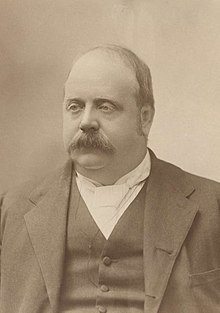| Revision as of 23:58, 5 November 2006 editBrownHairedGirl (talk | contribs)Autopatrolled, Extended confirmed users, File movers, Pending changes reviewers, Rollbackers2,942,733 edits revert uniltaeral cahnges of cistituency name; please resume discussion at Wikipedia_talk:WikiProject_UK_Parliament_constituencies#St_George.27s_Hanover_Square← Previous edit | Revision as of 00:17, 6 November 2006 edit undoFys (talk | contribs)14,706 edits →External links: broken linkNext edit → | ||
| Line 50: | Line 50: | ||
| {{s-par|uk}} | {{s-par|uk}} | ||
| {{succession box | {{succession box | ||
| | title = ] for ] | | title = ] for ] | ||
| | years = 1916––1918 | | years = 1916––1918 | ||
| | before = ] | | before = ] | ||
Revision as of 00:17, 6 November 2006
For other people named George Reid, see George Reid (disambiguation).| Rt Hon Sir George Reid | |
|---|---|
 | |
| 4th Prime Minister of Australia | |
| In office 18 August, 1904 – 5 July, 1905 | |
| Preceded by | Chris Watson |
| Succeeded by | Alfred Deakin |
| Personal details | |
| Born | 25 February 1845 Renfrewshire, Scotland |
| Died | 12 September 1918 |
| Political party | Free Trade/Anti-Socialist |
Sir George Houstoun Reid (25 February 1845 – 12 September 1918), Australian politician and fourth Prime Minister of Australia, was born in Johnstone, Renfrewshire, Scotland, son of a Church of Scotland minister, migrated to Victoria with his family as a child. His family was one of many Presbyterian families brought out from Scotland by Rev Dr John Dunmore Lang. He was educated at what later became Scotch College, but when the family moved to Sydney Reid obtained a job as a clerk. Joining the colonial public service, he rose rapidly and in 1878 he became head of the Attorney-General's department. He also published several books on political questions, notably free trade.
Qualifying as a barrister in 1879, he obtained a seat in the New South Wales Legislative Assembly in 1880, and held a seat in the New South Wales Parliament until Federation of Australia in 1901. He succeeded Sir Henry Parkes as leader of the Free Trade Party, and became Premier of New South Wales in 1894 at the head of a progressive ministry supported by the Labour Party.
In 1899, however, he fell out with Labour and resigned. By this time Reid had grown hugely fat and sported a walrus moustache and a monocle, but his buffoonish image concealed a shrewd political brain.
Reid supported the federation of the Australian colonies, but since the campaign was led by his Protectionist opponent Edmund Barton he did not take a leading role. When the proposed federal constitution was put to a referendum in New South Wales in 1899, he took the unusual position of saying that although he was opposed to it, he would personally vote for it. This earned him the nick-name "Yes-No Reid." The referendum was defeated, and Reid was able to secure greater concessions for New South Wales.
Reid was elected to the first federal Parliament as MP for East Sydney in 1901. Labor no longer trusted him and gave their support to the Barton government, so Reid became the first Leader of the Opposition, a position well-suited to his robust debating style and rollicking sense of humour. He improved his party's position in the 1903 elections, and in August 1904, when the Watson government resigned, he became Prime Minister.
Reid did not have a majority in either House, and he knew it would be only a matter of time before the Deakin's Protectionists patched up their differences with Labor, so he enjoyed himself in office while he could. In July 1905 the other two parties duly voted him out, and he left office with a good grace. He gained seats once more in 1906, but failed to win a majority.
In 1908, when Deakin proposed a "Fusion" of the two non-Labor parties, Reid stood aside from leadership. In 1910 he resigned from Parliament and was appointed as Australia's first High Commissioner in London.
Reid was extremely popular in Britain, and in 1916, when his term as High Commissioner ended, he was elected to the House of Commons for the seat of St George, Hanover Square as a Unionist candidate, where he acted as a spokesman for the self-governing Dominions in supporting the war effort. He died suddenly in London in September 1918, aged 73.
Reid's posthumous reputation suffered from the general acceptance of protectionist policies by all parties, as well as from his buffoonish public image. In 1989 W. G. McMinn published George Reid (Melbourne University Press), a serious biography designed to rescue Reid from his reputation as a clownish reactionary and show his Free Trade policies as having been vindicated by history.
See also
External links
- George Reid - Australia's Prime Ministers / National Archives of Australia
| Political offices | ||
|---|---|---|
| Preceded byGeorge Dibbs | Premier of New South Wales 1894–1899 |
Succeeded byWilliam Lyne |
| Preceded byNone | Leader of the Opposition 1901–1904 |
Succeeded byAlfred Deakin |
| Preceded byChris Watson | Prime Minister of Australia 1904 – 1905 |
Succeeded byAlfred Deakin |
| Parliament of the United Kingdom | ||
| Preceded bySir Alexander Henderson | Member of Parliament for St George, Hanover Square 1916––1918 |
Succeeded bySir Newton Moore |
- Prime Ministers of Australia
- Members of the Cabinet of Australia
- Premiers of New South Wales
- Free Trade Party politicians
- Australian politicians
- Members of the United Kingdom Parliament from English constituencies
- Australian Presbyterians
- Australian Freemasons
- Natives of Renfrewshire
- Scottish-Australians
- 1845 births
- 1918 deaths
- UK MPs 1910-1918